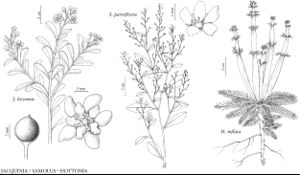Shrubs, trees, or perennial herbs, often evergreen, usually glandular-punctate or with secretory resin canals appearing as dark dots or streaks on vegetative and/or floral parts (sometimes somewhat obscure in Samolus). Leaves pseudoverticillate at ends of branches or alternate (some Samolus also with basal rosettes or reduced and scalelike leaves), simple; stipules absent; petiole present (often poorly differentiated in Samolus); blade margins entire or serrate. Inflorescences terminal and/or axillary racemes or panicles. Flowers bisexual [plants dioecious in Clavija], usually radially symmetric; perianth and androecium hypogynous (perigynous in Samolus); hypanthium usually absent (present in Samolus); sepals 5, distinct or connate proximally; petals 5, connate proximally, corolla usually campanulate or salverform [urceolate or subrotate]; stamens 5, antipetalous, epipetalous (free in some Samolus), distinct or closely aggregated (rarely connate); anthers dehiscent by longitudinal slits; staminodes 5 (sometimes absent in Samolus), antisepalous, epipetalous; pistils 1, 5+-carpellate; ovary superior to partly inferior (Samolus), 1-locular; placentation free-central with ± globose central axis; ovules anatropous, bitegmic, usually not embedded in placentae, tenuinucellate; styles 1; stigmas 1, truncate to capitate or lobed. Fruits baccate or capsular, dehiscence loculicidal (Samolus). Seeds 1–50+, light to dark brown, ± angular, globose or flattened; embryo dicotyledonous, straight; endosperm copious, starchless.
Distribution
Widespread, mainly neotropical with Samolus cosmopolitan.
Discussion
Genera 7, species ca. 100 (3 genera, 6 species in the flora).
Theophrastaceae are of little economic importance; some species of Jacquinia are used to make tropical fish poisons; fruits of the tropical Clavija Ruiz & Pavón are edible. All genera apparently are pollinated by insects (bees, flies, midges), with nectar and pollen as rewards (B. Ståhl and M. Källersjö 2004).
Theophrastaceae are closely related to Myrsinaceae (often included by some in the latter) and Primulaceae, and are considered less advanced than either. Samolus had been included in Primulaceae; the semi-inferior ovary, along with staminodal anatomy and mostly Southern Hemisphere distribution, made it an anomaly in that family. M. Källersjö et al. (2000) have shown that Samolus is a sister taxon to Theophrastaceae and should be included in that family (as done here) or placed in a monotypic Samolaceae (B. Ståhl & Källersjö 2004). See further discussion under Primulaceae.
Selected References
None.
Illustrations
Key
| 1 | Perennial herbs; fruits capsular. | Samolus |
| 1 | Shrubs or trees; fruits baccate | > 2 |
| 2 | Young branches puberulous, hairs relatively short, uniseriate; corollas yellow or orange; seeds flattened, partially covered by placental tissue. | Bonellia |
| 2 | Young branches lepidote, hairs irregularly branched, thick-walled; corollas white or cream; seeds subglobose, completely covered by placental tissue | Jacquinia |

